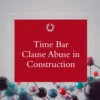
Ram Subramanian

𝗔𝘀𝗰𝗲𝗿𝘁𝗮𝗶𝗻𝗶𝗻𝗴 𝗹𝗼𝘀𝘀 𝗮𝗻𝗱 𝗱𝗮𝗺𝗮𝗴𝗲𝘀 𝗶𝗻 𝗖𝗼𝗻𝘀𝘁𝗿𝘂𝗰𝘁𝗶𝗼𝗻 𝗔𝗿𝗯𝗶𝘁𝗿𝗮𝘁𝗶𝗼𝗻 – 𝗥𝗜𝗖𝗦 𝗴𝘂𝗶𝗱𝗲𝗹𝗶𝗻𝗲 (2024 edition)
Background to contractual loss and expense clauses
👉It is important from the outset to be aware of the background to the development of loss and expense clauses in construction contracts, for that reason some of the important cases are detailed in the following section. One of the earliest legal cases that is still quoted today to deal with this issue is Hadley v Baxendale (1854).
👉Following that case, when it is asked ‘What is the amount of damages to which an injured party is entitled for breach of contract?’, the answer is generally ‘an injured party may recover those damages reasonably considered to arise naturally from a breach of contract, or those damages within the reasonable contemplation of the parties at the time of contracting’.
👉The details of this case were that a shaft in Hadley’s mill broke, rendering the mill inoperable. Hadley hired Baxendale to transport the broken mill shaft to an engineer in Greenwich so that he could make a duplicate. Hadley told Baxendale that the shaft must be sent immediately, and Baxendale promised to deliver it the next day.
👉Baxendale was negligent and did not transport the mill shaft as promised, causing the mill to remain shut down for an additional five days. Hadley had paid a sum of £2 and 4 shillings to transport the mill shaft and sued for £300 in damages due to lost profits and wages. The jury at that time awarded Hadley £25 beyond the amount already paid to the court and Baxendale appealed.
👉Prior to Hadley v Baxendale the usual rule was that the claimant was entitled to the amount they would have received if the breaching party had performed, i.e. the plaintiff (the contractor, for example) is placed in the same position it would have been in had the breaching party performed. Under this rule, Hadley would have been entitled to recover lost profits from the five extra days the mill was inoperable.
👉The court held that if there were unique or special circumstances under which the contract had been made, then only if those circumstances were known to both parties at the time they made the contract would any breach of the contract result in damages that would naturally flow from those unique or special circumstances.
👉 Consequential damages are linked to what has been termed as foreseeability at the time of contracting. These damages are effectively for loss other than those arising naturally. Back to modern times and courts tend to use foreseeability as the cornerstone to determine consequential damages. Ultimately what is reasonably foreseeable at the time of contracting requires evidence of the circumstances under which the contractor/client entered into the contract and the documents/knowledge that they possessed at that time.
#construction #disputeresolution #international #rics
Choose ADROIT as your Expert Advisor!
A-202 Oak Canopy, Trichy Road,
Coimbatore - 641 005,
Tamil Nadu, India.
Post Box 228, Postal Code 211,
Muscat - Oman.
This website has been designed only for the purposes of dissemination of basic information on ADROIT; information which is otherwise available on the internet, various public platforms and social media. Careful attention has been given to ensure that the information provided herein is accurate and up-to-date.
This website is not an attempt to advertise or solicit clients and does not seek to create or invite any lawyer-client relationship. The links provided on this website are to facilitate access to basic information on ADROIT, and, to share the various thought leadership initiatives undertaken by it. The content herein or on such links should not be construed as a legal reference or legal advice. Readers are advised not to act on any information contained herein or on the links and should refer to legal counsels and experts in their respective jurisdictions for further information and to determine its impact.
